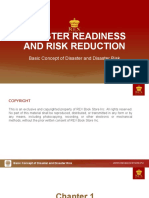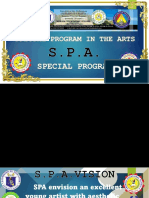0 ratings0% found this document useful (0 votes)
117 viewsVarious Contemporary Art Forms and Their Practices From The Various Regions
Various Contemporary Art Forms and Their Practices From The Various Regions
Uploaded by
Roselyn L. Dela CruzThis document discusses various contemporary art forms and their practices from different regions. It provides examples of visual art forms like painting, sculpture and architecture from the Philippines. Some key points discussed include National Artist Fernando Amorsolo's painting "Spoliarium" , sculptures like the "Higantes" of Angono and the Manunggul Jar. Examples of architecture mentioned are Burnham Park in Baguio and Barasoain Church in Malolos, recognized for their historical significance. The document also explores contemporary dance forms native to the Philippines like Tinikling, Pangalay and Sinulog.
Copyright:
© All Rights Reserved
Available Formats
Download as PPTX, PDF, TXT or read online from Scribd
Various Contemporary Art Forms and Their Practices From The Various Regions
Various Contemporary Art Forms and Their Practices From The Various Regions
Uploaded by
Roselyn L. Dela Cruz0 ratings0% found this document useful (0 votes)
117 views55 pagesThis document discusses various contemporary art forms and their practices from different regions. It provides examples of visual art forms like painting, sculpture and architecture from the Philippines. Some key points discussed include National Artist Fernando Amorsolo's painting "Spoliarium" , sculptures like the "Higantes" of Angono and the Manunggul Jar. Examples of architecture mentioned are Burnham Park in Baguio and Barasoain Church in Malolos, recognized for their historical significance. The document also explores contemporary dance forms native to the Philippines like Tinikling, Pangalay and Sinulog.
Original Title
ARTS
Copyright
© © All Rights Reserved
Available Formats
PPTX, PDF, TXT or read online from Scribd
Share this document
Did you find this document useful?
Is this content inappropriate?
This document discusses various contemporary art forms and their practices from different regions. It provides examples of visual art forms like painting, sculpture and architecture from the Philippines. Some key points discussed include National Artist Fernando Amorsolo's painting "Spoliarium" , sculptures like the "Higantes" of Angono and the Manunggul Jar. Examples of architecture mentioned are Burnham Park in Baguio and Barasoain Church in Malolos, recognized for their historical significance. The document also explores contemporary dance forms native to the Philippines like Tinikling, Pangalay and Sinulog.
Copyright:
© All Rights Reserved
Available Formats
Download as PPTX, PDF, TXT or read online from Scribd
Download as pptx, pdf, or txt
0 ratings0% found this document useful (0 votes)
117 views55 pagesVarious Contemporary Art Forms and Their Practices From The Various Regions
Various Contemporary Art Forms and Their Practices From The Various Regions
Uploaded by
Roselyn L. Dela CruzThis document discusses various contemporary art forms and their practices from different regions. It provides examples of visual art forms like painting, sculpture and architecture from the Philippines. Some key points discussed include National Artist Fernando Amorsolo's painting "Spoliarium" , sculptures like the "Higantes" of Angono and the Manunggul Jar. Examples of architecture mentioned are Burnham Park in Baguio and Barasoain Church in Malolos, recognized for their historical significance. The document also explores contemporary dance forms native to the Philippines like Tinikling, Pangalay and Sinulog.
Copyright:
© All Rights Reserved
Available Formats
Download as PPTX, PDF, TXT or read online from Scribd
Download as pptx, pdf, or txt
You are on page 1of 55
Various Contemporary Art Forms
and their Practices from the
various Regions
Instruction:
1. Tell what art form is represented by the picture;
2. Identify the region where it belongs.
Direction: Arrange the jumbled letters to
find out the major art forms in the Philippine
Contemporary arts.
1. sart aluvis
2. aliterarute
3. cuism
4. trehate
5. acned
6. cratethicure
7. milf
Art. plays a significant part in the rich cultural identity of
the Philippines. It mirrors the Filipino people, its history, its
tradition, and the country as a whole. These art forms
developed from the early times continue to evolve up to the
present. From the ethnic tradition, it continues to progress
to contemporary art tradition.
• Contemporary art is the art of today, produced by artists who are living in
the twenty-first century.
• Contemporary art of the 21st century may combine elements of
performance, painting, sculpture, dance, and many other media. It draws on
the movements of modern art, including minimalism and assemblage art, to
create dynamic pieces that aim to challenge the viewer and spark thought.
Many contemporary artists use their work to comment on cultural and
political issues, including race, human rights, economic inequality, and
global conflict. As the world continues to change and impact human life on a
large scale, art continues to experiment with new ways of reaching its
audience.
Visual arts are art forms such as painting, drawing,
printmaking, sculpture, ceramics, photography,
video, filmmaking, design, crafts, and architecture.
Many artistic disciplines such as performing arts,
conceptual art, textile arts also involve aspects of
visual arts as well as arts of other types.
Sculpture as defined and as practiced in the Philippine
Contemporary arts made use of different materials like the
variety of woods, metals, and stones. Some produced
creative works using plastics, jade, brass, and other
materials.
THE HIGANTES OF ANGONO by: Mailah Balde.
The “Higantes” is a sculpture made of paper-mache. This
paper-mache, in our native town in Paete, Laguna calls it
“taka.” The “Higantes” measures four to five feet in
diameter and ten to twelve feet in height. The “Higantes”
represents “mag-anak” (family) in the Filipino culture; a
father, a mother, and the children. The “Higantes” is one of
the main attraction in the annual festival in Angono, Rizal
in honor of St. Clement, patron saint of the fisher folks held
every 23rd of November.
It is a sculpture of the legendary
bird or artificial cock that has becomes
omnipresent symbol of Maranaw art. It is
depicted as a fowl with wings and feathered
tail, holding a fish on its beak or talons. The
head is profusely decorated with scroll, leaf,
and spiral motifs.
Bahayan – Munting Pangarap a
sculpture that depicts the reality of life in
the squatter area in Malabon.
THE MANUNGGUL Jar
It is a secondary burial jar
excavated from a
Neolithic burial site in
Tabon Caves at Lipuun
Point in Palawan.
THE BOHOL BLOOD
COMPACT sculpture was made
by the National Artist, Napoleon
Abueva, a Boholano himself. This
Sikatuna-Legaspi blood compact is
considered as the First Treaty of
Friendship between two different
races, religions, cultures and
civilizations.
This monument designed and
executed by National Artist for
Sculpture Napoleon
Abueva drew its inspiration
from the call to arms by then
President Fidel Valdez Ramos
to the Filipino people to meet
the new millennium with
courage and optimism, fortified
by a vision termed by FVR as
Philippines 2000.
“Painting is the practice of applying pigment suspended
in a carrier (or medium) and a binding agent (a glue) to a
surface (support) such as paper, canvass, or wall.
Painting is also used to express spiritual motifs and
ideas; sites of this kind of painting range from artwork
depicting mythological figures on pottery to The Sistine
Chapel and to the human body itself.”
Spoliarium - it was made by Luna in
1884 as an entry to the prestigious Exposicion
de Bellas Artes (Madrid Art Exposition, May
1884) and eventually won for him the First
Gold Medal. The painting features a glimpse
of Roman history centered on the bloody
carnage brought by gladiatorial matches.
Spoliarium is a Latin word referring to the
basement of the Roman Colosseum where the
fallen and dying gladiators are dumped.
Contrast –a painting that
captures the feeling of
heaviness and pain of a slum
dweller against the
background of a building that
looks abandoned.
The Builders (Victorio
Edades) – a painting that
depicts the struggle of each
builder to earn for the family.
“Bayanihan” is a masterpiece
of Carlos “Botong” Francisco.
It depicted the resilience of the
Filipino people in times of
need, adversity, and disaster. It
showed the true character of
the Philippine folks as a
distinct human race.
“A mural is any piece of artwork
painted or applied directly on a
wall, ceiling or other permanent
surfaces. A distinguishing
characteristic of mural painting is
that the architectural elements of
the given space are harmoniously
incorporated into the picture.”
The painting of Carlos V. Francisco
“The First Mass in the
Philippines” believed to be finished
in between 1955 to 1960. The mass
was celebrated in Limasawa Island
on the day of Easter. It is believed in
the painting that whatever is the
person’s nationality, as long as that
person was there to attend the mass,
that person is accepted.
Dance – art of the human form, body is used, mobilized
and choreographed in a specific time, form and space.
Cariñosa - is a Philippine
national dance performed by
two individuals wearing María
Clara suit and Barong tagalog ;
it is from Philippine folk
dances.
Sinkil dance takes its
name from the bells worn
on the ankles of the
Muslim princess. Perhaps
one of the oldest of truly
Filipino dances, the Singkil
recounts the epic legend
of the "Darangan" of the
Maranao people of
Mindanao.
Pandanggo sa Ilaw - is a very
popular folk dance in the
Philippines. It is said to have
originated from Mindoro, the
seventh-largest island in the
Philippines. This dance of
lights simulates fireflies at
dusk and at night.
Pangalay has a number of versions
including the Pangalay Linggisan,
which is performed by a solo female
dancer imitating the movement of a
bird in flight. e Pangalay performed
in characterized by the graceful
movement of the dancer's arms and
hands flowing in synchrony the
gentle blowing of the wind.
Tinikling - Philippine dance
which involves two individual
performers hitting bamboo
poles, using them to beat, tap,
and slide on the ground, in
coordination with one or more
dancers who steps over and in
between poles.
Hadalaya Festival - The
northernmost town of Cebu,
Daan bantayan, celebrates a
festival in honor of the warrior
Datu Daya of Kandaya.
Sinulog Festival - dance ritual
of the miraculous image of
Sto. Niño held annually in
Cebu.
Architecture Designs and Allied Arts- structure that meant
to be used as shelter, its art relies on the design and purpose of
the structure.
The “tsalet” is a type of house
developed in the early 2oth
century designed with a front
porch made of wood and
concrete. During this time,
steel was used in buildings as
protection for calamities like
earthquake.
This is Calle Crisologo, a
famous street in the town of
Vigan, Ilocos Sur, Philippines.
Vigan is considered as a World
Heritage Site because it is one
of a few existing Hispanic
towns in the Philippines. The
distinctive style of buildings
and structures is a fusion of
Philippine, oriental, and
colonial European architecture.
Burnham Park Architectural
design named after Daniel
Burnham, an American architect
who was the city planner for
Baguio. He designed the park and
the original plans for the city
simultaneously, and construction
began around 1904. The park
played an important role when it
served as a place of refuge for the
people of Baguio following a
devastating earthquake in 1990.
Quiapo Church, also
known as the Minor
Basilica of the Black
Nazarene, is the site of the
annual January Black
Nazarene procession. One
of Manila’s most famous
churches, Quiapo
The Rizal Shrine in
Calamba is a reproduction
of the original two-story,
Spanish-Colonial style
house in Calamba, Laguna
The Cultural Center of the
Philippines is the brainchild of
Philippine First Lady Imelda Marcos
and came into being with President
Ferdinand Marcos’ Executive Order
No. 30. Its purpose was to promote
and preserve Filipino arts and culture.
It was built from 1966 to 1969 and
designed by two National Artists,
Leandro Locsin for the architecture
and Ildefonso Santos Jr. for the
landscape architecture.
Intramuros was rebuilt
with Spanish colonial
style. Numerous architects,
urban planners and
professors are critical of the
way Intramuros was
restored, describing it as
frozen in time.
UST Main Building represents the
height of civilizational achievement
of the Philippines. It is an
architectural jewel, an engineering
marvel (nothing less than the first
earthquake-resistant building in
Asia!), historic locus, and hallowed
ground. If the Philippine state could
be believed, it’s a National Cultural
Treasure; in fact, it was declared so
by the National Museum of the
Philippines in 2010 in the run-up to
UST’s 400th anniversary in 2011 as
Asia’s oldest university.
Barasoain Church (also
known as Our Lady of Mt.
Carmel Parish) is a Roman
Catholic church built in 1630
in Malolos City, Bulacan.
Having earned the title as the
Cradle of Democracy in the
East, the most important
religious building in the
Philippines, and the site of the
First Philippine Republic, the
Church is proverbial for its
historical importance among
Filipinos.
The Ivatan House
is made primarily of lime,
stone, wood and thatch.
Basilica de San Martin de
Tours or Taal Basilica is one of
the oldest church in Philippine
History.
Film – a technological translation of theater, special effects are
utilized to enhance the story telling.
Dekada 70 – based on the novel
of Lualhati Bautista, a film of Chito
Roño. It is all about family and life
in the presence of Martial Law. It
shows the importance of
understanding, love and respect
towards your family.
Mariquina – a story and film of
Milo Sogueco. The rise, fall and
revival of shoemaking in Marikina,
the footwear capital of the
Philippines are unravelled through
the story of Imelda and Romeo,
aided by a delightfully rare
cinematic appearance by the
former first lady and patroness of
shoes, Imelda Marcos. The father-
daughter struggle illustrates the
challenge of a nation trying to re-
establish its identity.
Kulintas of Agusan National
High School, Butuan
City, about childhood buddies
separated by poverty, one of
whom is invited by his
classmates to join a rebel
group until his conscience
bothers him and he surrenders
to the police.
The 1975 film tells the story of
Julio Madiaga, a young fisherman
from the province who goes to the
big city to look for his long-lost
beloved, Ligaya Paraiso. While
searching for her, Julio is exposed
to the ills and violence in the city.
Himala (Miracle) is definitely a
Filipino cinema masterpiece. ...
Himala is the story of Elsa, a woman
from a forgotten place in the
Philippines called Cupang. Her
visions of the Virgin Mary change
her life and cause a sensation
hysteria in a poor, isolated northern
village in the midst of drought.
You might also like
- Various Contemporary Art Forms and Their Practices From The Various RegionsDocument37 pagesVarious Contemporary Art Forms and Their Practices From The Various RegionsRoselyn L. Dela Cruz100% (3)
- Various Contemporary Art Forms and Their Practices From The Various RegionsDocument37 pagesVarious Contemporary Art Forms and Their Practices From The Various RegionsRoselyn L. Dela Cruz100% (3)
- 7 - Walmart Supply Chain Case StudyDocument17 pages7 - Walmart Supply Chain Case StudyYash Chandak100% (1)
- BuddeComm Intelligence Report - Coronavirus (Covid-19) and The Telecoms SectorDocument41 pagesBuddeComm Intelligence Report - Coronavirus (Covid-19) and The Telecoms SectorAngel ChiangNo ratings yet
- Smith Adam Edi Ielts Writing Task 2Document130 pagesSmith Adam Edi Ielts Writing Task 2Nhung Le85% (34)
- CAR Module 1Document38 pagesCAR Module 1Christian DenoraNo ratings yet
- Module 1Document70 pagesModule 1Hersheys Ferrero Toblerones LptNo ratings yet
- Contemporary Filipino Artists 4Document82 pagesContemporary Filipino Artists 4Kenneth EsguerraNo ratings yet
- Philippine Literature - Unit 1Document12 pagesPhilippine Literature - Unit 1Mariel C. BombitaNo ratings yet
- Cpar Quiz 1Document1 pageCpar Quiz 1robeNo ratings yet
- CPAR - Lesson 1Document82 pagesCPAR - Lesson 1Arminda VillaminNo ratings yet
- Contemporary Art FormsDocument17 pagesContemporary Art FormsAnnabelle ApostolNo ratings yet
- Entrep Hand OutDocument25 pagesEntrep Hand OutKnightmare9871100% (1)
- Lecture in Principles of Marketing 1Document19 pagesLecture in Principles of Marketing 1angelicelywongNo ratings yet
- Cpar M1Document54 pagesCpar M1Gea MojicaNo ratings yet
- Lesson 5 National Artists ConphilDocument58 pagesLesson 5 National Artists ConphilPsyrah GuintoNo ratings yet
- Summative 2nd Quarter PhilosophyDocument19 pagesSummative 2nd Quarter PhilosophyCristine Grace AcuyanNo ratings yet
- Contemporary Philippine Arts From The Regions: Learning Activtiy SheetDocument73 pagesContemporary Philippine Arts From The Regions: Learning Activtiy SheetKyle Arvin PatauegNo ratings yet
- 2nd Summative Test in Contemporary Philippine Arts From The RegionDocument3 pages2nd Summative Test in Contemporary Philippine Arts From The RegionLorena Barit Costales-RuecoNo ratings yet
- LAS 3rd Quarter No.4 P.E and Health 12Document11 pagesLAS 3rd Quarter No.4 P.E and Health 12HERMINIA PANCITONo ratings yet
- UcspDocument2 pagesUcspMicah AlingatongNo ratings yet
- A Brief History of Philippine Art 1.0Document23 pagesA Brief History of Philippine Art 1.0Jhay SeresacNo ratings yet
- Aerobic Exercise DefinitionDocument31 pagesAerobic Exercise Definitiontanishka SinghalNo ratings yet
- Worksheet 1: Contemporary Arts First SemesterDocument11 pagesWorksheet 1: Contemporary Arts First SemesterKrystal JungNo ratings yet
- Form Pre-Conquest Spanish Period 1521 - 1898 American Period 1898-1940 Japanese Period 1941-45 Postwar Republic 1946 - 1969 70's - Contempor AryDocument73 pagesForm Pre-Conquest Spanish Period 1521 - 1898 American Period 1898-1940 Japanese Period 1941-45 Postwar Republic 1946 - 1969 70's - Contempor AryJoebel CristalesNo ratings yet
- Contemporary ArtsDocument9 pagesContemporary Artsxilen clevNo ratings yet
- SHS - Grade 12 - Contemporary Philippine Arts From The Regions - Francia, Clarissa E3Document3 pagesSHS - Grade 12 - Contemporary Philippine Arts From The Regions - Francia, Clarissa E3CLARISSA FRANCIANo ratings yet
- A.Content Standards: The Learner Demonstrates Appreciation of Contemporary Art Forms, Found in TheDocument2 pagesA.Content Standards: The Learner Demonstrates Appreciation of Contemporary Art Forms, Found in TheRupelma Salazar PatnugotNo ratings yet
- DLL For Demo 2020Document1 pageDLL For Demo 2020Lee Dumalaga Carinan0% (1)
- Principles of MKTG - Qtr3 W1Document39 pagesPrinciples of MKTG - Qtr3 W1Renato SolidumNo ratings yet
- Quiz 1Document1 pageQuiz 1WinstonEnriquezFernandez100% (2)
- What Is A Disaster?: Kristine Joy Osillos-CortesDocument31 pagesWhat Is A Disaster?: Kristine Joy Osillos-CortesJoshua Parungao AggalutNo ratings yet
- Weekly Learning Activity Sheet Solomon P. Lozada National High School Contemporary Philippine Arts From The Region 2 Quarter - Week 5Document7 pagesWeekly Learning Activity Sheet Solomon P. Lozada National High School Contemporary Philippine Arts From The Region 2 Quarter - Week 5RutchelNo ratings yet
- Orca Share Media1563275252300Document109 pagesOrca Share Media1563275252300Jorjie TarasinaNo ratings yet
- Marketing Chapter 4Document97 pagesMarketing Chapter 4Nicole SisonNo ratings yet
- CPAR Quarter 1 Module 1Document48 pagesCPAR Quarter 1 Module 1BlackInk21No ratings yet
- Per DevDocument49 pagesPer DevDarling MallariNo ratings yet
- Week 9-10Document7 pagesWeek 9-10Catherine FernandezNo ratings yet
- Contemp Lesson6 7Document43 pagesContemp Lesson6 7Jennifer ArnaizNo ratings yet
- Forms of ArtsDocument146 pagesForms of Artsjillene catapangNo ratings yet
- Contemporary Philippine Arts From The RegionsDocument78 pagesContemporary Philippine Arts From The RegionsRheena-Ann DupaleNo ratings yet
- Tungkil National High School Tungkil, Minglanilla, Cebu: Personal Development S.Y. 2021-2022Document2 pagesTungkil National High School Tungkil, Minglanilla, Cebu: Personal Development S.Y. 2021-2022Mark Paul AlvarezNo ratings yet
- 2nd Q MODULE 2 - 21st Century LitDocument9 pages2nd Q MODULE 2 - 21st Century LitJuan Carlos Dado-aconNo ratings yet
- National Dance ArtistsDocument30 pagesNational Dance ArtistsMa Cyril SantosNo ratings yet
- Summative TestDocument2 pagesSummative Testtorjak shinNo ratings yet
- TQ 2nd WITH ANSWER KEYDocument4 pagesTQ 2nd WITH ANSWER KEYAizajane Delos ReyesNo ratings yet
- Q4 Week6-ModuleDocument10 pagesQ4 Week6-Moduleyojchie de villNo ratings yet
- Contemporary Philippine Arts From The Regions Quarter 1 - Module 1Document15 pagesContemporary Philippine Arts From The Regions Quarter 1 - Module 1Charlene MagleoNo ratings yet
- Contemp WEEK 9Document11 pagesContemp WEEK 9Crystal Joy Aepole GalaponNo ratings yet
- PromotionDocument32 pagesPromotionAditya SoodNo ratings yet
- PE ReviewerDocument2 pagesPE Reviewerjswiftie_123No ratings yet
- 1 Basic Concept of Disaster and Disaster Risk-2Document27 pages1 Basic Concept of Disaster and Disaster Risk-2John Serrio OdaibmacNo ratings yet
- Cpar Week2Document38 pagesCpar Week2AJ AguilarNo ratings yet
- ENTREPDocument4 pagesENTREPMikeNo ratings yet
- Act 1.2 Evolution of ManDocument3 pagesAct 1.2 Evolution of ManRay FaustinoNo ratings yet
- SLK - Contemporary Art 12 - Q1 - LC2Document30 pagesSLK - Contemporary Art 12 - Q1 - LC2SHEEN ALUBANo ratings yet
- Outdoor Recreation 2019Document20 pagesOutdoor Recreation 2019Christian Bjorn CunananNo ratings yet
- CPAR-Lesson-1 3Document36 pagesCPAR-Lesson-1 3RoseNo ratings yet
- Dance RubricsDocument4 pagesDance RubricsBeni LanuzaNo ratings yet
- HOPE 3 Lesson 1 Elements of DanceDocument29 pagesHOPE 3 Lesson 1 Elements of DanceJay El Taypin OrdanezaNo ratings yet
- CPAR 2nd ExamDocument2 pagesCPAR 2nd ExamAlexander ArranguezNo ratings yet
- History-Of-Contemporary ArtDocument33 pagesHistory-Of-Contemporary ArtMARSNo ratings yet
- CPAR ReportDocument25 pagesCPAR ReportPong PongNo ratings yet
- Development of Visual Art in The Philippines 5Document3 pagesDevelopment of Visual Art in The Philippines 5Uzziah Gonzales94% (17)
- Pre TestDocument28 pagesPre TestRoselyn L. Dela CruzNo ratings yet
- Crossword ysbm2BEAtsDocument1 pageCrossword ysbm2BEAtsRoselyn L. Dela CruzNo ratings yet
- Week 5Document39 pagesWeek 5Roselyn L. Dela CruzNo ratings yet
- 12-0014 Roselyn L. Dela Cruz - Filipdis Bsais 3aDocument150 pages12-0014 Roselyn L. Dela Cruz - Filipdis Bsais 3aRoselyn L. Dela CruzNo ratings yet
- Incorporate ContemporaryDocument21 pagesIncorporate ContemporaryRoselyn L. Dela CruzNo ratings yet
- Think of Word That Best Describe You, Constract A 4-5 Sentences Why? Be Ready To Recite ItDocument38 pagesThink of Word That Best Describe You, Constract A 4-5 Sentences Why? Be Ready To Recite ItRoselyn L. Dela Cruz100% (1)
- SCRIPTDocument3 pagesSCRIPTRoselyn L. Dela CruzNo ratings yet
- The Organs of Speech and Their FunctionsDocument28 pagesThe Organs of Speech and Their FunctionsRoselyn L. Dela CruzNo ratings yet
- Various Contemporary Art Forms andDocument62 pagesVarious Contemporary Art Forms andRoselyn L. Dela CruzNo ratings yet
- CPARDocument80 pagesCPARRoselyn L. Dela CruzNo ratings yet
- Integrative Art As Applied To Contemporary ArtDocument40 pagesIntegrative Art As Applied To Contemporary ArtRoselyn L. Dela CruzNo ratings yet
- CPARDocument26 pagesCPARRoselyn L. Dela CruzNo ratings yet
- Psychological Perspective of The SelfDocument16 pagesPsychological Perspective of The SelfRoselyn L. Dela Cruz100% (1)
- Psychological Perspective of The SelfDocument16 pagesPsychological Perspective of The SelfRoselyn L. Dela Cruz100% (1)
- Behavior ChangeDocument19 pagesBehavior ChangeRoselyn L. Dela CruzNo ratings yet
- Think of Word That Best Describe You, Constract A 4-5 Sentences Why? Be Ready To Recite ItDocument49 pagesThink of Word That Best Describe You, Constract A 4-5 Sentences Why? Be Ready To Recite ItRoselyn L. Dela CruzNo ratings yet
- Awards and Decorations of The Pakistan Armed ForcesDocument17 pagesAwards and Decorations of The Pakistan Armed ForcesShamshad GadiNo ratings yet
- Lesson Plan in Bookkeeping For DemoDocument5 pagesLesson Plan in Bookkeeping For DemoJudy BalaseNo ratings yet
- File Name JurnalDocument14 pagesFile Name JurnalFormat Seorang LegendaNo ratings yet
- Minecraft Player CommandsDocument19 pagesMinecraft Player CommandsIsabel Fireseed100% (4)
- 74LVC2G240Document17 pages74LVC2G240Hamzah JaNo ratings yet
- Steal This Site!: Case StudyDocument1 pageSteal This Site!: Case StudyJoshua MALACASNo ratings yet
- Level: 3Ms . Group: .. Full Name: .Document3 pagesLevel: 3Ms . Group: .. Full Name: .Samira BedadNo ratings yet
- 21 DPR of LJN Div 24-25Document25 pages21 DPR of LJN Div 24-25CTA/ TRD/LJNNo ratings yet
- Ar. Rashmi S. Tijare: COA No: CA/2004/34877 Contact No: +91 7875948928 EmailDocument10 pagesAr. Rashmi S. Tijare: COA No: CA/2004/34877 Contact No: +91 7875948928 EmailAnonymous Qm0zbNkNo ratings yet
- Ageing of Steam Generators (IAEA TECDOC-981) (1997)Document181 pagesAgeing of Steam Generators (IAEA TECDOC-981) (1997)Meliha ŠabanovićNo ratings yet
- Airbus A320-214 Cebu Pacific Special StickerDocument17 pagesAirbus A320-214 Cebu Pacific Special StickermaverickbarsaloteNo ratings yet
- Vendor Registration Sop Ver 2.2Document33 pagesVendor Registration Sop Ver 2.2Ayaskant KanungoNo ratings yet
- Jtekt e Report2016Document142 pagesJtekt e Report2016Amit AryaNo ratings yet
- Compact Cotton YarnDocument5 pagesCompact Cotton Yarnmlganesh666No ratings yet
- COUNTRY FEATURE Forecasting Omans IslamiDocument2 pagesCOUNTRY FEATURE Forecasting Omans IslamiSahirr SahirNo ratings yet
- BLF645Document14 pagesBLF645adam_tomasNo ratings yet
- Why CDocument9 pagesWhy CMuhammedNo ratings yet
- 21st Century Skills PaperDocument8 pages21st Century Skills PaperemilyraleyNo ratings yet
- Copia de Carra - My Autobiography - Jamie Carragher & Kenny DalglishDocument330 pagesCopia de Carra - My Autobiography - Jamie Carragher & Kenny DalglishSergio Garcés GómezNo ratings yet
- Special Program in The ArtsDocument30 pagesSpecial Program in The Artsnestor castanos jrNo ratings yet
- Genetics Activities StudentDocument78 pagesGenetics Activities StudentupmzamoNo ratings yet
- East and West Hararghe Monthly Situational Update September 2020Document9 pagesEast and West Hararghe Monthly Situational Update September 2020tadesse beyene0% (1)
- Geography Optional Geographical Thought SAMPLE Sunya IAS PDFDocument24 pagesGeography Optional Geographical Thought SAMPLE Sunya IAS PDFSamridh Sakolia0% (1)
- Valuation of GoodwillDocument3 pagesValuation of GoodwillSANDEEP CHAURENo ratings yet
- Redox TitrationDocument3 pagesRedox TitrationSubhamshaNo ratings yet
- CE144 OOPC Unit-01Document30 pagesCE144 OOPC Unit-01Priyanshu PurohitNo ratings yet







































































































